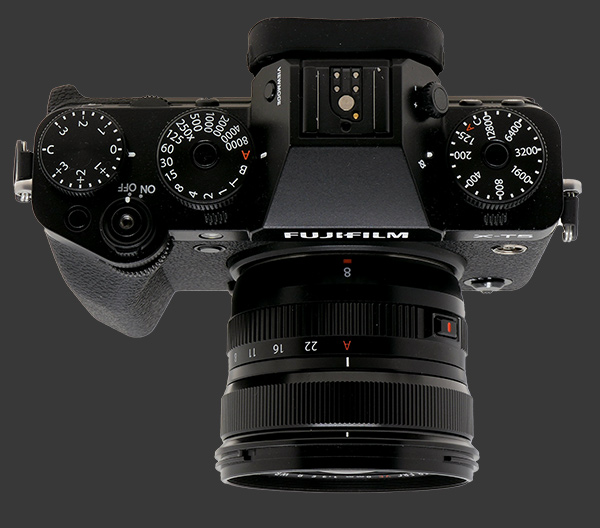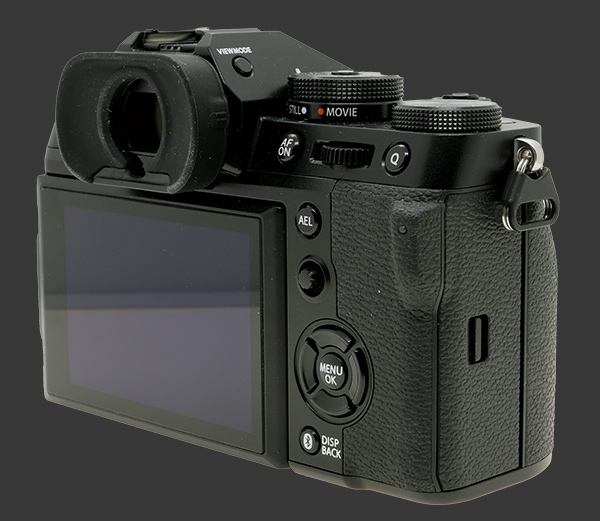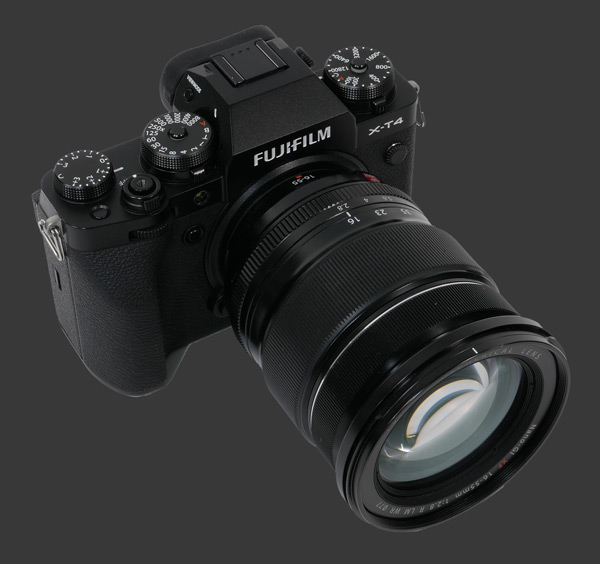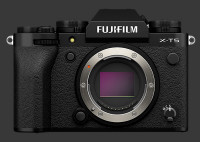Fujifilm X-T5 Review
Fujifilm X-T5 Performance - How well does it take pictures?
Performance starts with image quality, which is the criteria used as the foundation of our digital camera ratings. Ergonomic issues may get in the way, but in the end, image quality counts the most. For an ILC, image quality greatly depends on the lens used. While color, noise, exposure and dynamic-range are properties of a camera, distortion, vignetting and chromatic aberrations are properties of the lens. Sharpness and contrast depend on the weakest link. That is, a camera cannot capture more details than a lens lets through. Conversely, it is quite possible for a lens to transmit more details than a sensor can capture.
Although the sensor in the Fujifilm X-T5 is the same component used in the X-H2, these cameras do not use the same processor. This results in different image qualities due to processing which is mostly visible starting at mid-range ISO sensitivities. The end result is that the output of the X-T5 appears sharper from a certain sensitivity upwards. Read on for details.

Image Noise & Details
The new 40 Megapixels APS-C sensor in the Fujifilm X-T5 has the highest resolution of any APS-C camera. This gives it the smallest pixel-pitch of any digital camera sensor, the equivalent of a hypothetical 100 MP Full-Frame sensor, even though sensors that size max out at 61 MP to date. With such tiny pixels, the noise level of this new sensor is truly impressive.
Even though the 40 MP X-Trans CMOS 5 HR boasts a resolution 50% higher than the previous generation 26 MP X-Trans CMOS 4, it manages to match its extremely low noise from ISO 64 to 200. This performance makes it possible to make clean 30" x 20" prints, previously only possible using a Full-Frame or larger sensor! The X-Trans CMOS 5 HR sensor captures a tremendous amount of detail without being affected by moire.
At ISO 400, noise is absolutely minimal. It is just barely noticeable at 100% which still makes 30" x 20" prints look really good and 27" x 18" absolutely impeccable. So, while per-pixel noise is fractionally higher, this results in larger usable prints than 4th-generation sensors. Very fine details are rendered exceptionally well and contrast remains intact.
Image-noise starts becoming noticeable at ISO 800 when seen at full magnification. Its very fine noise pattern leaves fine detail virtually intact and only reduces maximum print sizes slightly. A large 24" x 16" print looks impeccable and stands up to close-inspection well. Contrast is unaffected by this little noise. At this ISO, the X-T5 is capable of capturing 400% the base dynamic-range - an extra 2-stops - which lets it maintain deep blacks even in the presence of noise.

ISO 1600 looks a little noisy upon close inspection. The fine noise-pattern damages only the finest details but it remains barely visible at anything less than maximum size. One can easily make a beautiful large moderately large print at this sensitivity. Both image contrast and dynamic-range are maintained quite well, better than on the X-H2 which is more tuned for video.
Image quality takes a moderate drop at ISO 3200, although appreciably less than on the X-H2. Details become a little soft and edges get damaged by noise. Contrast is only a fractionally lower. Given a high 40 megapixels of resolution, it is possible to produce good mid-size prints up to 21" x 15". Colors stay very consistent and noise only affects the luminance channel.
The trend continues progressively up to ISO 6400. It brings another moderate loss of image-quality with details damaged by noise-reduction. At this point, the X-T5 benefits from over a full stop lead over the X-H2. Expect reasonable mid-size prints of 18" x 12". These will not stand to close inspection but look fine at typical viewing distances. Impressively, contrast and dynamic-range are similar to ISO 3200.
The last standard sensitivity of ISO 12800 is clearly worse yet usable for small prints and scaled down for online use. Given its incredibly tiny pixels, this performance is better than expected. Noise is concentrated in the luminance channel with a reduction in dynamic range but remarkably accurate colors. It is possible to push sensitivity 2 more stops in the expanded range but only ISO 25600 remains usable for emergencies.
Sharpness can be controlled in 9 levels. The lowest -4 setting is extremely soft and the highest +4 is certainly over sharpened. The default setting of zero is on the soft side. By pushing sharpness to +1, images become much crisper without any artifacts. Note that on the X-H2, it was necessary to push Sharpness to +2 and its output was still softer! This only comes down to processing. Further improvement in image-quality can be obtained by reducing High ISO noise-reduction to -2. Keep in mind that these units are completely arbitrary.

The color and white-balance behavior are identical between the X-T5 and X-H2, as is exposure. There is only a tiny difference in dynamic-range. Those who read the Fujifilm X-H2 review can skip to the Autofocus section.
Color & White Balance
Fujifilm colors are better than most. Accuracy is very good with mostly realistic hues. There is a tendency to shift towards red which can be corrected easily. To obtain optimal colors right in-camera, use the standard Provia film simulation with the Color parameter set to zero. An additional richness can be added by switching both Color Chrome Effect and Color Chrome FX Blue to Weak. Note that Strong settings are clearly unnatural.
There are 3 Automatic White-Balance modes on the Fujifilm X-T5. The new White-Priority mode delivers neutral results under most conditions. It differs slightly in color temperature compared to standard AWB in the presence of artificial lighting. A third Ambiance AWB mode skews towards warm colors but very slightly, producing natural looking results with minimal effort from the photographer.
Under low-light, Automatic White-Balance modes, even the White Priority variant, starts leaving a yellow cast that gets more pronounced with artificial light sources. A WB Preset greatly improves the situation, while WB Fine-Tuning along 2-axis in 19 steps makes it possible to neutralize nearly any color-cast. Falling back to Custom White-Balance provides much more accurate colors in difficult situations.
Exposure & Dynamic-Range
The Multi-Segment metering system of the X-T5 is extremely reliable and very consistent. This system is tuned for a centered exposure which limits areas of both over and under exposure. Unless the scene dynamic-range exceeds the sensor latitude, exposure almost never off by more and 2/3 EV. It is important to know that Shutter-Priority mode, the preview is not Exposure-Priority cannot be relied upon to preview exposure.
Normally digital cameras with smaller pixels have a narrower dynamic range yet Fujifilm somehow managed to make the X-T5 capture an very wide dynamic range at low sensitivities. Maximum dynamic range is achieved at ISO 800 which can reliably capture scenes with 14-stops of dynamic-range when the camera is configured to 400% DR. From ISO 200 and 400, a fraction less than 14-stops can be captured. ISO 100 and 64 are Expanded ISO sensitivities which clip dynamic-range to 13-stops.
This extremely impressive dynamic-range ends above ISO 800 when it gradually decreases by ½-stops for each full-stop of sensitivity. At ISO 12800 and beyond, the drop off becomes more pronounced and exceeds one stop between consecutive ISO because additional image noise fills up dark pixels. Just like other high-resolution cameras, the X-T5 works better at low sensitivities where noise is low and dynamic-range is high.
The Fujifilm X-T5 offers a Dynamic-Range Priority mode. This can be turned off or set to weak or strong levels. In this mode, Dynamic Range, Shadow Tone and Highlight Tone settings are locked out and the camera takes into account feedback from the sensor to optimize all those settings. Generally though, tuning Shadow Tone to -½ delivers good and consistent results.
For scenes that exceed the dynamic-range of the Fujifilm X-T5, the camera offers builtin HDR. Each HDR frame is made by capturing 3 frames with exposure varying by 1, 2, 3 or 4 stops. The result is merged in-camera with a short lag, about one second. There are 4 selectable levels: 200% DR, 400% DR, 800% and 800%+.
Clarity affects mid-tone contrast which provides the illusion of increased subject detail. Unfortunately, applying Clarity is resource intensive which introduces a notable camera lag at any Clarity setting other than the default of zero. This makes the X-T5 feel sluggish. Images with Clarity set to +1 or 2 look great without seeming unnatural.

Auto Focus
A fully hybrid autofocus system inside the X-T3 combines on-sensor Phase-Detect AF, Contrast-Detect and AI training. The hardware is incredibly sensitive with Phase-Detection working down to -7 EV, one of the lowest light levels of any camera. Contrast-Detection assists in less dark environments.
A virtual 425-Point AF system is presented as an abstraction for simplicity. To allow photographers to work faster, every other point can be skipped which leaves 117 points selectable. Technically, each point is actually an area that possibly includes hundreds or thousands of phase-detection elements. This make it possible to select 6 focus-area sizes, which are the same whether or not every other point gets skipped. Areas can be grouped together in clusters of 3x3, 5x5 or 7x7 to select autofocus more broadly. The larger the zone, the more data is available to compute focus.
Autofocus is extremely quick and decisive even in low light. When light is very dim, the AF system can exhibit a very short lag, mostly when the smallest areas are selected. By widening for focus area, autofocus becomes nearly instantaneous even when little light is present. This is one of the fastest autofocus system around.

Tracking autofocus works extremely well and keeps a steady lock on moving subjects up to a certain speed. Recognized subjets can be tracked all the way to edges of the frame. The Fujifilm X-T5 shows the focus area instantly, helping the photographer confirm that focus is locked onto the intended target.
Equally impressive is the accuracy of this hybrid autofocus system. It rarely misses focus and recovers quickly after switching between subjects that differ significantly in distance. Unlike other mirrorless, this model focuses with the aperture wide-open which gives it a consistent focusing-speed regardless of the selected aperture. There are virtually no focus misses in single-shot AF mode.
Speed
Every control on the Fujifilm X-T5 produces an instantaneous response. Navigating the menu, reviewing images and configuring settings also happens without delay. This superb speed even applies to the Eye-Start Sensor which switches between the EVF and LCD instantly. The soft shutter allows images to be captured without delay.
Focus happens immediately, even under very dim lighting. Confirmation and feedback are shown without delay which makes manual focusing a breeze. When subject tracking is enabled, the tracking frame moves in sync with the subject. The 15 FPS continuous drive is outstandingly fast, particularly considering it is acheived using a mechanical shutter.
These measurements characterize the performance of the Fujifilm X-T5:
- Power-On: 1s, without sensor-cleaning. Average.
- Power-On to First-Shot: 1¼ seconds. Good.
- Autofocus: Faster than ¼s, down to very dim light. Best-in-class.
- Shutter-lag: Instant without blackout. Spectacular.
- Shot-to-shot: 2/3s with AF. ½ with MF. Good.
- Playback: 1½s to enter, 1s to exit. Slow.
- Power-Off: 2s without sensor cleaning. Slow.
- Video: Variable, between ½-1s to start, immediate stop with 1½s delay after. Average.
The X-T5 is capable of being speedy. The good news is that the camera performs best where it counts the most. Autofocus is virtually instant and shutter-lag is inexistant. Responsiveness is also fantastic, as long as Clarity is left to its default value. While benchmarking, there were several outliers which seem related to power saving settings. Although there is no official correlation, the better numbers, show above, were acheived when disabling Auto Power Off mode. Otherwise, there were erratic delay toggling playback mode and upon startup.
It is possible that Fujifilm is agressively powering down components to save energy and occasional delays are caused by reactivating them. This would also explain why battery-life is so good. Fujifilm rates it at 580 shots-per-charge which is acheivable. Switching into Playback mode can be abysmally slow, even using some of the fastest memory cards available. The startup delay gets repeated each time the camera wakes up from sleep mode. This is one time when the X-T5 can hold back the photographer. Luckily, it is possible to stop the camera from entering sleep mode.
The proprietary lithium-ion battery that powes this camera holds a good amount of charge. It is unfortunate that, even with such a costly camera, no charger is provided. There is a power adapter to charge internally but this comes with plenty of disadvantages:
- The camera is tied down while charing a battery. It is not possible to shoot while another battery is charging.
- The camera must be kept out and plugged in, increasing changes of accidents.
- One cannot leave a battery charging at the hotel while away shooting.
- If the USB port got damaged, the camera would be out-of-commission.
Fujifilm X-T5 Performance - How well does it shoot video?
Given there is a current Fujifilm flagship APS-C mirrorless designed for uncompromising video performance, the X-H2, it is important to determine what limits were given to the X-T5. The headline difference between the two models is that the X-H2 is capable of 8K video capture. By now, most people probably know that this is a resolution with 4X more pixels than 4K. Currently, 8K has very little traction among consumers due to primarily the lack of media, followed by the difficulty in transmitting 8K video and finally the high cost of 8K televisions.
8K cameras are intented to create content ahead of its widespread adoption.
The maximum video resolution that the X-T5 can capture is 6240 x 3510, referred to by Fujifilm as 6.2K. There are no displays for this non-standard resolution and those are unlikely to ever be made. This resolution is useful though to produce 4K video after some intense processing to extract an Ultra 4K or Cinema 4K stream from it. This allows videographers to add panning motion and stabilization in post-processing. In this mode the X-T5 has maximum frame rate of 30 FPS.
The ultra-high resolution sensor in the Fujifilm X-T5 makes it possible to record video with supreme quality. The camera offers numerous modes, codecs, bit-depth and bit-rates to manage the volume of storage required. The maximum bit-rate supported is 360 Mbps which is selectable for any combination of resolution and frame-rate.

Maximum video quality is produced at 4K Ultra-HD at 24 FPS encoded as Quicktime using a 10-bit H.265 All-Intra codec with 360 Mbps bit-rate. Detail in such videos are impeccable. The camera captured very fine details and renders them without artifacts due to it oversampling a 6.2K stream using a sensor that is impervious to moire. Nuances in tone and color are also well-captured due to 10-bit encoding. Note that 10-bit encoding in video is 10-bit per pixel, not per channel, so it is viewable on most televisions and displays.
Motion at 24 FPS is not entirely smooth which is refereed to as cinematic. It is possibly the most widely expected difference between movies and television. The X-T5 can also capture 30 FPS and very smooth 60 FPS video. Using on of its high bit-rate codecs, 200 or 360 Mbps, even fast motion looks continuous with no noticeable artifacts. For faster frame-rates, 100-240 FPS can be captured at Full HD and Cinema HD resolutions. When exceeding 60 FPS, videos can be played back at a slower frame-rate than captured.
The high-speed electronic-shutter inside this mirrorless does an excellent job at minimizing motion artifacts during capture. In video that shows large objects moving or includes panning motion, it is important to choose a high bit-rate to prevent compression from introducing visual artifacts. For 4K video, it is best to stay at 200+ Mbps and, for HD video, 100 Mbps should be considered the minimum.
Output options are plentiful. The X-T5 is one of the few cameras that is capable of storing video simultaneously into two memory cards. It can also record and output video simultaneously. HDMI output supports a RAW format and allows for a different frame-rate.
As hinted by performance measurements above, there is sometimes and unfortunate delay when video capture starts. In 4K mode with plenty of frame-rates, video recording starts reasonably after a tiny but noticeable lag. With 6.2K capture and certain 4K configurations, there can easily be a one second delay between when the shutter-release is pressed and recording starts.

The Fujifilm X-T5 thankfully has a dedicated Movie mode. This makes it correctly preview video framing, which every camera should do but is not always the case. Switching into Movie mode also adds more pages to the menu system in addition to extra settings in the Video menu tab. Two pages are added, one for Audio and the other for Time-Code.
Audio is highly configurable with Auto, Manual or Disabled input. In Manual input mode, the audio level can be adjust from -30 to +6 dB. The level can be set independently for the internal microphone and the external stereo input. There is also an Audio Limiter, a Wind Filter and a Low-Cut Filter. The stereo input mini-jack supports microphone and line input.
Time Code is supported by this camera, a feature only normally found in serious video cameras. It can be displayed or not and the start time can be manually entered or taken from the internal clock. There is an option to include Time Code in the HDMI output too. The X-T5 is equipped with front and rear lights to indicate that the camera is recording. Settings include options to use the front, back, both or none in steady or blinking mode.
Fujifilm X-T5 Conclusion

Fujifilm leveled up the X-T series with this latest addition. The much higher resolution 40 megapixels X-Trans CMOS 5 HR cropped-sensor of the X-T5 plus an upgraded 5-axis image-stabilization system effective to 7-stops make this a worthy upgrade from the X-T4. The fact that the Fujifilm X-T5 manages to overtake its predecessor in virtually all areas is impressive. Most photographers will favor the 50% resolution increase over the 25% lower burst rate.
The Fujifilm X-T5 consistently delivers on all fronts. Image quality is top-notch, capturing more detail than any other APS-C camera. Noise starts very low and climbs relatively slowly. Crucially, the X-T5 maintains great dynamic-range, contrast and color all the way up to ISO 6400. Color accuracy and white-balance are on-point with fine controls to adjust the final output to taste.
This digital camera is capable of handling any photographic subject thanks to a truly effective image-stabilization system, a class-leading shutter-speed range and broad sensitivity range. A rich feature set, including expansive bracketing modes, automatic focus bracketing, builtin HDR and more give photographers all the tools they need. The analog design of this camera provides efficient controls that are highly customizable.
Even though its resolution is high, this camera is surprisingly quick. The autofocus system is particularly fast, very reliable and incredibly sensitive, down to -7 EV. This allows the X-T5 to photograph near darkness. Its 15 FPS continuous drive is really impressive and can reach 20 FPS in exchange for a 1.3X crop. Under most conditions, this camera is quite responsive, although a few settings can slow it down more than usual.
Extensive video capabilities are built into the Fujifilm X-T5. It has a huge number of options to record 4K video and even offers 6.2K capture at up to 30 FPS. The quality of video output from this camera is excellent. Other than an occasional delay with certain video configurations, this mirrorless is highly usable for videography.
A sturdy weatherproof body with dual control-dials, large number of external controls and dual SDXC UHS-II memory-card slots give the X-T5 a complete professional feature-set. The new larger 0.8X magnification 3.7 megapixels 0.5" OLED EVF with Eye-Start sensor delivers a really comfortable viewing experience.
Fujifilm produced yet another outstanding camera with the X-T5, one that exceeds most performance aspects of its predecessor and the X-H2 while avoid several issues it presented by the latter. For photography, the X-T5 is more capable and handles noticeably better.
 |
Please Support Neocamera
All information on Neocamera is provided free of charge yet running this website is a huge endeavor. Purchases made via affiliate links found throughout the site help keep it running and up-to-date. There is no additional cost to you, so please consider buying via these links to our affilates:
If you found any information on this site valuable and did not purchase via our affiliate links, please considering donating via PayPal:
Any amount will be greatly appreaciated. Thank you for your support!
Fujifilm X-T5 Highlights

Sensor-Size: 24 x 16mm

Actual size when viewed at 100 DPI
| 40 Megapixels Mirrorless | ISO 64-51200 |
| Fujifilm X Mount 1.5X FLM | Shutter 1/180000-900s |
| 5-Axis Built-in Stabilization, 7-Stop Improvement | Full manual controls, including Manual Focus |
| 0.50" Built-in EVF 3.7 Megapixels (0.80X) | Custom white-balance with 2 axis fine-tuning |
| Automatic Eye-Start sensor | Spot-Metering |
| 2 Axis Digital Level | Hot-Shoe & Sync-Port |
| Weatherproof down to -10C | Stereo audio input |
| Built-in Dust Reduction | Lithium-Ion Battery |
| 13 FPS Drive, 163 Images | Secure Digital Extended Capacity x 2 |
| 6240x3510 @ 30 FPS Video Recording | |
| 3" LCD 1.8 Megapixels |
Updates
2024.05.09

Fujifilm GFX100 II Review
Flagship 102 Megapixels Medium-Format Mirrorless Digital Camera with 8-Stop 5-Axis IBIS, 8 FPS Drive, 8K Video and 400 MP Super-Resolution capture in a weatherproof and freezeproof body with dual control-dials and dual memory-card slots.
2024.04.03

Fujifilm X-T5 Review
Newest Fujifilm flagship boasting a 40 MP APS-C sensor, 5-axis IBIS with 7-stop efficiency, 15 FPS continuous drive, 6.2K Video capture, dual control-dials and dual SDXC UHS-II slots in a sturdy weatherproof and freezeproof body.
2023.11.20

Best Digital Cameras of 2023
Find out which are the Best Digital Cameras of 2023. All the new Mirrorless Digital Cameras from entry-level to high-end professional.
2023.07.10

Fujifilm X-H2 Review
40 Megapixels APS-C Hybrid Mirrorless Digital Camera with 7-stop IBIS. Fastest shutter ever and 8K video capture. Large builtin EVF with 0.8X magnification and 5.8 MP, plus an Eye-Start Sensor. Packed with features and large number of controls in a weatherproof and freezeproof body.
2023.05.07

Sony FE 20-70mm F/4G Review
Review of the unique Sony FE 20-70mm F/4G lens. The optical zoom of this lens spans ultra-wide-angle and medium focal-length coverage, making it one of the most versatile Full-Frame lenses on the market.
2023.01.15

Huion Inspiroy Dial 2 Review
Review of the Huion Inspiroy Dial 2 tablet, a medium sized drawing surface with dual dials and customizable buttons. Connects via USB-C or Bluetooth 5.0 with Windows, Linux and Android support.
2022.12.08

How to Pack for a Photo Trip
Find out how to pack for a travel photography trip, carry your gear safely while meeting airline regulations.
2022.11.13

Best Digital Cameras of 2022
The best digital cameras of 2022. A short list of the most outstanding models in their respective categories. Choose one for yourself or as a gift.
2022.09.21

Pentax DA* 60-250mm F/4 SDM Review
Review of the Pentax DA* 60-250mm F/4 SDM, the constant-aperture telephoto zoom with the highest zoom-ratio on the market.
2022.09.20

Pentax DA* 50-135mm F/2.8 SDM Review
Review of the Pentax DA* 50-135mm F/2.8 SDM, the lightest professional telephoto zoom native to the K-mount.
2022.09.10

Pentax DA* 11-18mm F/2.8 DC AW Review
Review of the Pentax DA* 11-18mm F/2.8 DC AW, the widest professional ultra-wide zoom native to the K-mount.
2021.11.24

50 Gifts Under $50 For Photographers in 2021
50 Gifts photographers will love. All for under $50 USD. 2021 Edition.













